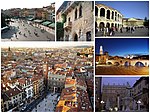Palazzo Canossa, Verona
Buildings and structures completed in 1527Houses completed in the 16th centuryItalian palace stubsPalaces in VeronaRenaissance architecture in Verona

Palazzo Canossa is a palace in Verona, northern Italy. It was erected by commission of the Marquises of Canossa to architect Michele Sanmicheli in 1527, not far from the Arco dei Gavi and the Castelvecchio. Palazzo Canossa is in Mannerist style, with the entrance preceded by a notable portico. One of the ceilings had frescoes by Gian Battista Tiepolo, but they were lost during the bombings of Verona during World War II. In its history, the palace housed important figures such as Tsar Alexander I of Russia, Napoleon Bonaparte and Emperor Francis I of Austria.
Excerpt from the Wikipedia article Palazzo Canossa, Verona (License: CC BY-SA 3.0, Authors, Images).Palazzo Canossa, Verona
Corso Cavour, Verona San Zeno
Geographical coordinates (GPS) Address External links Nearby Places Show on map
Geographical coordinates (GPS)
| Latitude | Longitude |
|---|---|
| N 45.440277777778 ° | E 10.989722222222 ° |
Address
Palazzo Canossa
Corso Cavour
37121 Verona, San Zeno
Veneto, Italy
Open on Google Maps










